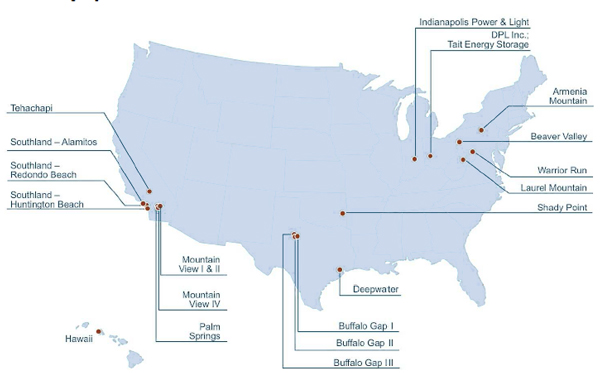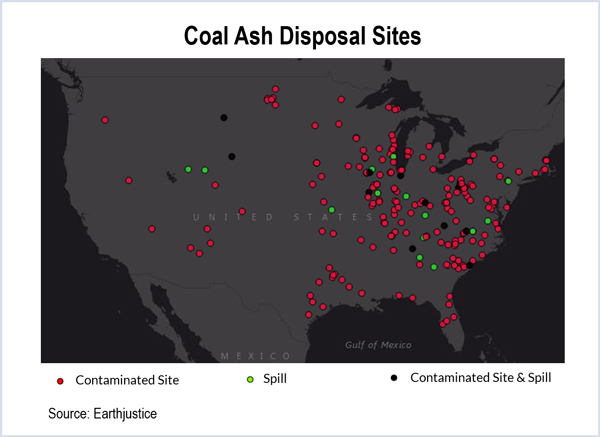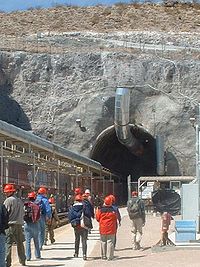SWEPCO Drops Bid for $116 Million Tx Line

“Based on SPP’s new findings, we are notifying landowners, community leaders and elected officials that we have withdrawn our application to the [Public Service Commission] for authority to construct the Shipe Road to Kings River transmission project,” said Venita McCellon-Allen, SWEPCO’s president.
The 345-kV line would have run between Benton and Carroll counties. It was a source of contention for both property owners and environmentalists. Opponents to the line successfully petitioned the PSC for a rehearing on the line. SPP is in the process of withdrawing its Notification to Construct, the basis for SWEPCO’s construction plans and application.
More: Arkansas Times
DELAWARE
Failed Data Center Project Spawns Lawsuit

Robert Krizman, who was recruited to work as president of The Data Centers LLC, filed suit in the Court of Chancery against chief executive Earl Kern, alleging that Kern kept him in the dark about business decisions. Krizman, who was also a minority partner in the project, wants to be released from his share of about $1 million in debt the project racked up.
After months of studies and lobbying, the university decided against hosting the project. Much of the community backlash that doomed the project centered on a proposed 279-MW power plant.
More: The News Journal
INDIANA
IPL Seeks First Rate Hike Since 1994

Although it has been more than two decades since IPL asked for a general rate hike, it has received other boosts, including 3% rate increases for system improvements for each year between 2013 and 2019. The company also filed a request in 2014 to add about $1 to each monthly bill to pay for the conversion of its Harding Street coal-fired plant to natural gas.
IPL’s general rate increase would generate $67.8 million a year in revenue and would boost the typical residential monthly bill by $8. If approved, it would take effect at the end of 2015.
More: Indianapolis Business Journal
IOWA
State’s Energy Expert Fired with No Explanation
Gov. Terry Branstad’s top energy expert was fired without notice last month, leaving a multi-million dollar energy fund without a leader.
Paritosh Kasotia, team leader of the state energy office, was asked to leave Dec. 8, according to an Associated Press report last week. Kasotia had just returned from a national energy conference when she was told she had been ousted, and she stopped working the same day.
Kasotia began overseeing the Office of Energy Independence under Democratic Gov. Chet Culver, administering grants in the $71 million Iowa Power Fund. Branstad, a Republican, began dismantling the fund after taking office in 2011, moving the energy office to the economic development agency.
More: Telegraph Herald
KENTUCKY
Another County Opposes Kinder Morgan NGL Plan
Opposition is mounting in the state against a plan by Kinder-Morgan Energy to convert its existing Tennessee Gas Pipeline to carry natural gas liquids from Appalachian shale fields to the Gulf Coast.
Marion County joined Boyle County in passing a resolution opposing Kinder-Morgan’s plan to repurpose the 71-year-old pipeline to carry a mixture of natural gas liquids like propane and butane to a Gulf Coast processing plant. The pipeline passes through 18 counties in Kentucky.
Marion County last year opposed construction of the Bluegrass Pipeline, which also would have carried NGLs. That pipeline died after a state judge ruled that its planners didn’t have eminent domain powers.
More: The Advocate Messenger
PSC Approves First Large-Scale Solar Plant
The Public Service Commission has approved construction of the first utility-scale solar plant in the state. Kentucky Utilities will own 61% of the 10-MW facility and Louisville Gas & Electric will own the remaining 39%.
The plant will be built on the site of KU’s E.W. Brown Generating Station in Mercer County, with its $36 million cost subsidized by ratepayers.
KU and LG&E originally applied to build both the solar plant and a 670-MW combined-cycle plant. Plans for the natural gas-fired plant were canceled after KU lost nine wholesale power contracts from municipal customers.
More: The State Journal
LOUISIANA
Industrial Boom Points Toward Need for New Power Plants
Low utility prices and cheap natural gas are fueling a boom in industrial growth in Louisiana, and utilities are struggling to keep up with demand. Entergy just fired up a new combined-cycle plant, but some estimates show that more plants, or more imported electricity, will be needed by the end of 2015, and still more by the end of 2019.
In addition to building new plants in Louisiana and Arkansas to meet demand, Entergy is purchasing even more power from wholesale markets. “All that will help, but ultimately we’re going to need to build new generation,” said Phillip R. May, head of Entergy’s Louisiana operations. “It has to be new steel in the ground to meet all of this new load. … We’re on the front end of a pretty steep curve in growth.”
Entergy has yet to file a multiyear rate increase request to help finance the need for new plants, but consumer advocates are already marshaling forces to block them if they do. “We don’t feel it’s fair that residential and commercial customers should have to foot the bill (for power) that will be needed primarily by the large industrial sector,” said Casey DeMoss Roberts, head of the Alliance for Affordable Energy. “The industrial customers should have a special rider to pay for it.”
More: The Advocate
MARYLAND
Judge Affirms PSC Ruling on Cove Point Power Plant

Circuit Court Judge Alfred Nance ruled the PSC did not act outside its authority when approving the power plant. The Accokeek, Mattawoman, Piscataway Creeks (AMP) Communities Council had appealed the PSC decision.
The power plant is part of Dominion’s $3.8 billion project to convert the LNG importation terminal into an export terminal.
More: BayNet
MISSISSIPPI
Cost of Kemper Plant Keeps Growing: Another $25 Million in Overruns Reported

Southern Co. said the overruns reduced its after-tax profit by $258 million in the third quarter. The Kemper plant is designed to convert soft lignite coal to gas that will fuel its boilers. Carbon dioxide from the combustion process is to be captured for industrial uses or storage underground.
Similar plants are also experiencing trouble. Duke Energy’s Edwardsport, Ind., plant suffered from construction delays and cost overruns. And FutureGen 2.0, a government-backed project in Illinois, was announced in 2003 and still isn’t operational.
More: Sun Herald
MISSOURI
Ameren Files $135 Million Energy Efficiency Plan
Ameren Missouri has filed a three-year, $135 million energy efficiency plan with the Public Service Commission, saying it would provide more than $260 million in benefits to its customers over 20 years. The company’s first energy efficiency plan, mandated by the state with the intention to cut energy use and reduce emissions, covers two years and runs out at the end of this year.
The new plan, which has 10 programs to help residential and business customers cut energy use and costs, provides incentives for energy-efficient heating and air conditioning equipment, appliances and lighting systems.
A company spokesman said the programs, together, could save up to 426,000 MWh. “That’s equivalent annual use of 33,000 average-size homes on our system, so it’s a very significant amount of savings on behalf of our customers,” Dan Laurent said.
More: St. Louis Public Radio
MONTANA
PSC Blocks Wind Power Agreement for NorthWestern

Greenfield Wind would have sold power to NorthWestern for $54/MWh under a 25-year contract. That compares to a recent hydro contract that did get PSC approval at $57 to $58 per megawatt hour.
Commission Chairman Bill Gallagher, one of the objecting voters, said tying the utility, and its ratepayers, into the wind power contract would cost it money when the wind power was available but not needed, and would be sold at a loss on the wholesale market. “The difference in that price is going to be left to the consumer,” Gallagher said.
More: Montana Standard
NEW JERSEY
BPU-Set Gas Rate Means Refunds for Some State Gas Customers
Elizabethtown Gas residential customers will get an average refund of $40 after the Board of Public Utilities approved a lower supply charge.
Company officials said the lower cost of gas from Marcellus Shale production will save its customers $10 million. The refund is on top of the lower gas rate approved by the BPU late last year.
“Essentially, there’s an abundant supply of natural gas now that’s serving to lower prices for customers,” said Duane Bourne, a company spokesman.
More: Elizabethtown Gas
Environmental Group Still Concerned About Pine Barrens Pipeline Project
A proposed natural gas pipeline through the Pine Barrens that failed to gain approval by the Pinelands Commission last year poses a “real cause of concern,” according to the year-end report of the Pinelands Preservation Alliance.
The environmental group’s “State of the Pinelands Report” said the commission’s deadlocked 7-7 vote on the pipeline shows that pressures still exist on the natural resources in the area. After the vote, Gov. Chris Christie nominated two new members for the commission, but those appointments were put on hold in a contentious legislative hearing that focused mostly on the pipeline proposal. South Jersey Gas wants to build the pipeline to fuel the B.L. England power plant, which is being converted from coal to natural gas.
“The most well-known threat to the integrity of the Pinelands protection rules over the past year is the South Jersey Gas pipeline issue,” the alliance’s report stated.
More: Shore News Today
NORTH DAKOTA
PSC Approves Another 172 MW of Wind Power at Antelope Hills
A $240 million wind farm on 22,000 acres in western North Dakota received approval from the Public Service Commission. The 86-turbine, 172-MW Antelope Hills Wind Project near Beulah, Mercer County will be in service by the end of this year, according to PSC Chairman Brian Kalk.
Basin Electric Cooperative has signed a 25-year power purchase contract for the full output of the new facility. It will be added to the 1,600 MW of wind power currently operating in the state and 1,200 MW of wind power already approved by the commission.
Antelope Hills has applied for a 9.5-mile, 345-kV transmission line to carry its output to a grid connection at Basin Electric’s Antelope Valley Station coal-fired plant.
More: Prairie Business
OHIO
FirstEnergy Sweetens the Pot for its Proposed Rate Plan
FirstEnergy, in an attempt to show support for its controversial “Powering Ohio’s Progress” electric security plan, filed a proposed joint settlement agreement with the Public Utilities Commission.
FirstEnergy’s proposal to receive supply guarantees for several power plants has prompted a backlash from opponents, who said the company had already been rewarded for its merchant plants during the state’s transition to market rates.
Now, in exchange for the price supports, FirstEnergy proposes a freeze on distribution rates through 2019, $23 million in economic development funding and up to $7 million in low-income funding. The company said it has the support of 15 parties, including the city of Akron, labor and various user groups. PUCO will schedule hearings on the plan soon. The commission’s staff hasn’t filed its comments yet.
More: The State Journal
PENNSYLVANIA
Sustainable Energy Board Meeting to Spotlight Coming Projects
The annual meeting of the Sustainable Energy Board on Jan. 15 will feature an update on projects for the state.
Met-Ed and Penelec will provide an overview and update on their mapping program that shows where sustainable energy grants were apportioned. West Penn Power will provide an overview of projects funded by its program and will talk about a sustainable energy fund bond program it recently launched with the state. PPL will report on an LED lighting project at Harrisburg International Airport. And PECO Energy will detail its new third-party financing project for renewable energy projects.
The meeting is set for 11 a.m. in Hearing Room 1 of the Commonwealth Keystone Building in Harrisburg.
More: PUC
SOUTH DAKOTA
Keystone May Have Votes in Congress, but State Approval Key
Incoming members of Congress may have approval of the Keystone XL Pipeline in their sights, but the Public Service Commission still needs to grant a crucial approval, and that may not be too easy. More than 40 groups have filed to intervene in the commission’s approval process.
The PSC approved the pipeline in 2010, but that construction permit expired last June. TransCanada has filed for a new construction permit, but most of the groups who have filed with the PSC are against the project.
The commission has scheduled hearings in February, March and April to consider what can be heard and filed at the final hearings, which are scheduled for May 5-8.
More: Economics 21
TEXAS
LNG Terminal Plans on Hold Due to Falling Gas Prices
Excelerate Energy told the Federal Energy Regulatory Commission that it is putting its floating liquefied natural gas terminal project near Port Lavaca on hold, partly because of plunging natural gas prices.
“Due to the recent global economic conditions, the company has determined that, at this time, this project no longer meets the financial criteria necessary in order for us to move forward with the capital investment,” the company announced last week. The company asked FERC to put its project filings on the shelf until April 1.
The export facility was to have been built in Lavanca Bay, about 30 miles southeast of Victoria. The $2.5 billion project would have been the first floating LNG export terminal in the U.S.
More: FuelFix
VIRGINIA
Residents Question Need for Line: Dominion Short on Answers
Northern Virginia residents have questioned the need for a transmission line proposed by Dominion Virginia Power to serve an unnamed high-tech client near Haymarket in Prince William County, west of Manassas National Battlefield Park.
Although Dominion won’t identify the customer, rumors abound that a major Amazon data center is planned for the area. Dominion spokeswoman Le-Ha Anderson said the utility’s existing lines aren’t large enough to supply the prospective client’s needs. Dominion estimates the costs of the new line and a substation are about $65 million.
Residents of Haymarket and surrounding areas say the proposed line would be unsightly and impact property prices. A town hall meeting for residents is scheduled for tonight at Battlefield High School.
More: Washington Business Journal
WEST VIRGINIA
PSC OKs Sale of 50% of Mitchell Plant to Wheeling

The 1,600-MW coal-fired plant, on the banks of the Ohio River in Moundsville, is 43 years old, but it recently had its emissions-control systems upgraded.
Another AEP subsidiary, Kentucky Power, owns the other half of the plant. The entire plant had been owned previously by AEP’s merchant generation business.
More: The State Journal
WYOMING
PSC to Let Cheyenne LF&P to Fix $5.1 Million Mistake
Cheyenne Light, Fuel & Power made a mistake when doing the calculations for its most recent rate case – a $5.1 million mistake. Its 2014 rate case left out a monthly collection from its residential customers of about $8.88 a month. This resulted in a collection shortfall for November and December of $985,875, which would grow to $5.1 million over a full year.
The company asked the Public Service Commission for permission to make up the difference on an interim basis, pending approval of a new rate case. The commission ruled in late December it would allow the company to re-file the rate case, but that ruling is on hold pending an appeal by two of Cheyenne’s industrial customers.
A decision is expected soon.
More: Wyoming Tribune Eagle
Energy Sector Drives Tax Revenues up by 13.2%
The state collected $43.2 million more in sales and use taxes during the first five months of its fiscal year, ending November. That’s good news for state officials, but there’s bad news on the horizon.
State finance officials say the strongest counties – Campbell, Laramie and Converse – collected $26.1 million of that, and much of that was due to energy industry jobs and services.
“From an industry perspective, the mining [including oil and gas], retail trade and construction sectors have captured most of the collection gains to date,” said Jim Robinson, principal economist for the Economic Analysis Division of the state Department of Workforce Services. But the recent plunge in natural gas and oil prices means tax collections in those counties are almost sure to drop as well.
More: Wyoming Business Report









